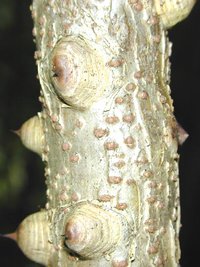Spine (biology)
|
|
Lightmatter_thorns.jpg
A spine is a rigid, pointed surface protrubance or needle-like structure on an animal, shell, or plant, presumably serving as a defense against attack by predators. For examples: the quills of a porcupine, the needles of a cactus, or the thorns of a shrub like the rose are all spines. Although spines generally serve as a passive defense mechanism, in some species they can be hollow and contain poisonous substances that cause lasting pain or even paralysis.
Plant spines and thorns
Botanists use several terms somewhat loosely when referring to spine- or needle-like structures on plants; however, the following differences are sometimes distinguished:
- prickle – a sharp outgrowth from the epidermis, also called an emergence and usually involving some subdermal tissue as well; see also hair.
- spine – a modified stipule or sharp branchlet found in a leaf axile or on the margin of a leaf.
- thorn – Sharp outgrowth from a stem other than at a node. Modified stem.
"Thorns", most notably those on roses, are common literary symbols for the hidden dangers or woes of something beautiful or pleasant. Roses lack true thorns since their prickles emerge from the epidermis rather that the pericycle. Growth from the pericycle would make it a modifided stem and therefore a thorn. Some roses have been bred not to have prickles.
See also
References
- Esau, K. 1965. Plant Anatomy, 2nd Edition. John Wiley & Sons. 767 pp.
- Llamas, K. A. 2003. Tropical Flowering Plants. Timber Press, Portland. 423 pp.

